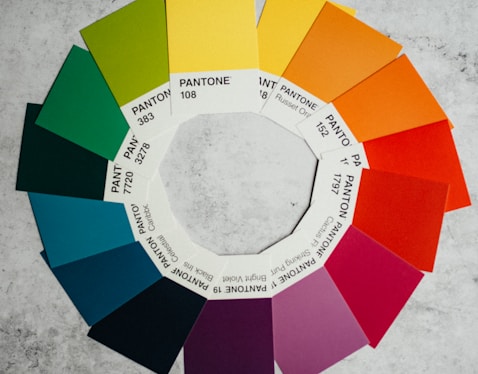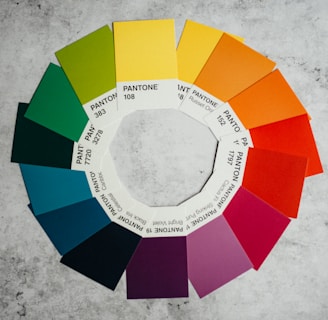Match Your Outfit and Accessories Using the Color Wheel
FASHION & LIFESTYLE
7/24/20233 min read


When it comes to fashion, one of the key elements that can make or break an outfit is the way colors are coordinated. Understanding the color wheel and how to use it can help you create stylish and harmonious combinations that enhance your overall look. In this article, we will explore what a color wheel is and how you can effectively coordinate colors in your clothing and accessories.
What is a Color Wheel?
A color wheel is a visual representation of colors arranged in a circular format. It consists of primary, secondary, and tertiary colors, and it helps us understand how different colors relate to each other. The color wheel is divided into different sections, each representing a specific color family.
The primary colors are red, blue, and yellow. These colors cannot be created by mixing other colors together and are the building blocks for all other colors. When primary colors are mixed, they create secondary colors: orange, green, and purple. Tertiary colors are created by mixing primary and secondary colors together.
The color wheel is a tool that can be used to create color schemes and coordinate colors in various aspects of our lives, including fashion.
Coordinating Colors in Clothing and Accessories
Now that we understand the basics of the color wheel, let's explore how we can use it to coordinate colors in our clothing and accessories:
1. Complementary Colors
Complementary colors are located opposite each other on the color wheel. These colors create a high contrast when paired together, making them visually striking. For example, if you're wearing a blue dress, you can pair it with a statement orange necklace or a pair of orange shoes. The contrast between the blue and orange will create a bold and eye-catching look.
2. Analogous Colors
Analogous colors are located next to each other on the color wheel. These colors create a harmonious and cohesive look when paired together. For instance, if you're wearing a green blouse, you can pair it with a yellow or blue accessory. This combination will create a visually pleasing and balanced outfit.
3. Monochromatic Colors
Monochromatic colors are different shades and tints of the same color. This color scheme creates a sophisticated and elegant look. For example, if you're wearing a black dress, you can accessorize with different shades of gray or silver. This monochromatic combination will create a chic and timeless outfit.
4. Triadic Colors
Triadic colors are three colors that are evenly spaced around the color wheel. This color combination creates a vibrant and balanced look. For instance, if you're wearing a red top, you can pair it with a blue skirt and a yellow accessory. The combination of these three colors will create a visually appealing and energetic outfit.
5. Neutral Colors
Neutral colors, such as black, white, gray, and beige, can be paired with almost any other color. They act as a canvas and provide a balanced backdrop for bolder or brighter colors. For example, if you're wearing a colorful printed dress, you can pair it with neutral accessories to let the print stand out.
Tips for Coordinating Colors
Now that you have a basic understanding of how to coordinate colors using the color wheel, here are some additional tips to help you create stylish and cohesive outfits:
1. Consider the Occasion
When coordinating colors, consider the occasion and the mood you want to convey. Bright and bold colors may be more suitable for casual or festive events, while muted or pastel colors may be more appropriate for formal occasions.
2. Experiment with Patterns and Textures
Don't be afraid to mix patterns and textures when coordinating colors. A patterned accessory or textured fabric can add depth and interest to your outfit.
3. Use Color Blocking
Color blocking is a technique where you pair solid blocks of color together. This can create a bold and modern look. For example, you can pair a solid red top with a solid blue skirt for a striking color-blocked outfit.
4. Consider Your Skin Tone
When choosing colors, consider your skin tone. Certain colors may complement your skin tone better than others. Experiment with different shades to find the ones that enhance your natural complexion.
5. Pay Attention to Proportions
When coordinating colors, consider the proportions of each color in your outfit. A general rule of thumb is to have one dominant color and use the other colors as accents.
Coordinating colors in your clothing and accessories can elevate your style and create a polished and put-together look. By understanding the color wheel and experimenting with different color combinations, you can create outfits that reflect your personal style and make a lasting impression. Remember to have fun and be creative with your color choices, and let the color wheel be your guide to achieving fashionable and coordinated looks.
Contacts
asharma@thestylebuzz.com
Subscribe to our newsletter
TheStyleBuzz offers informative content of a general nature. However, it is important to note that this information should not be considered as a substitute for professional medical advice, diagnosis, or treatment. TheStyleBuzz is committed to providing accurate and reliable information, but it is important to use your own discretion and seek professional advice when necessary.
